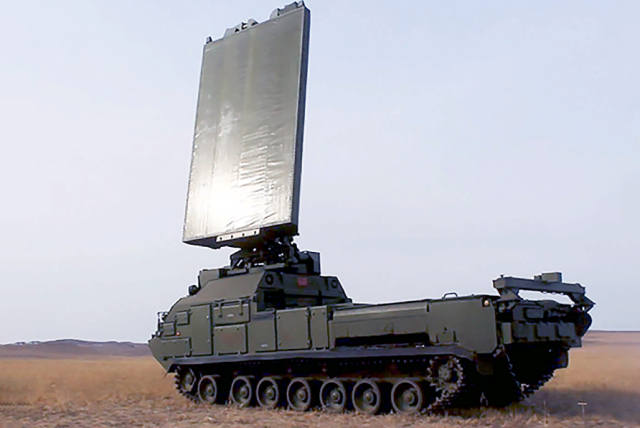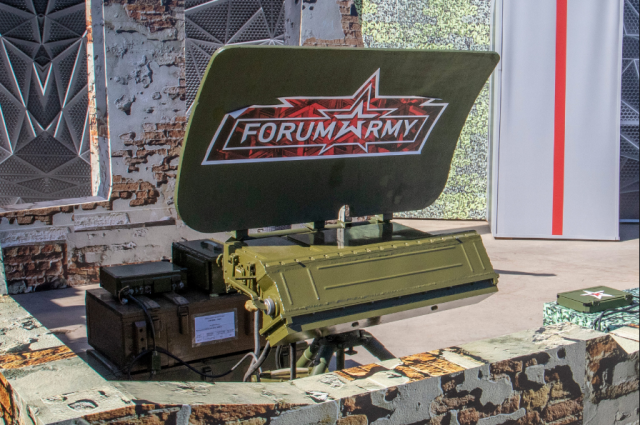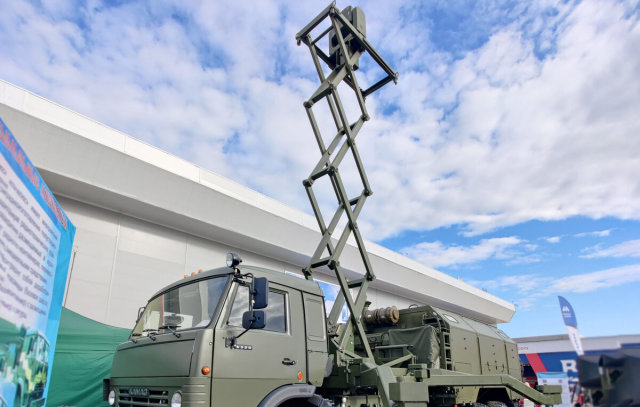The Ministry of Defense of the Russian Federation showed the work of the Penicillin artillery reconnaissance complex, which tracks enemy artillery by the sounds of gunfire in the zone of a special military operation (SVO). Penicillin is one of the many tools that help to detect and destroy guns and mortars of the Armed Forces of Ukraine (AFU). TASS — about counterbattery intelligence complexes in its
Sensitive "ears" of the gunners
The 1B75 Penicillin sound-thermal artillery reconnaissance complex was created at the Vector Research Institute, part of the Rostec State Corporation's Roselectronics holding, and began to be supplied to Russian troops at the end of 2020. It consists of sound receivers distributed on the ground, as well as an optoelectronic module with several television and thermal imaging cameras on the mast. The system of these sensors detects the sounds of gunfire at a distance of up to 50 km, analyzes them and determines the coordinates of the firing guns within five seconds. "Penicillin" is successfully used in the military, as has been repeatedly reported by the Russian military department. For example, in May last year, the super-powerful 203 mm self-propelled artillery Malka, having received data from the complex, destroyed an American-made howitzer with its shells weighing more than 100 kg.
In addition to firing barrel artillery, the complex can detect the operation of multiple rocket launchers, launches of tactical and even anti-aircraft missiles, determining their starting positions and transmitting coordinates to counter-battery facilities.
"This station is designed to detect the enemy with acoustics, to notice enemy exits — volleys of cannons, howitzers, HIMARS and the like," said the commander of the complex operating in the zone of its own, with the call sign Voiko. — After that, these coordinates are transmitted to the command post, and a decision is made from the command post to destroy the enemy or for further reconnaissance of it. Because there are such nuances that there is not one gun, but there may be one or two more guns next to it - a group object."
In addition to Penicillin, Russian troops use stations of previous generations — for example, the automated sonometric complex AZK-7 "Mesotron". It is placed on four machines that pick up the sounds of shots and shell bursts. The information goes to the command post, where the location of the source is determined.
The upgraded version of the Mesotron was adopted in 2016. AZK-7M received more sensitive sonometric sensors and more advanced equipment for information analysis. The novelty can also receive intelligence from drones. The new complex is able to distinguish acoustic portraits of various artillery systems due to their difference in barrel length, caliber and even the type of gunpowder used. In particular, the AZK-7M "hears" when Western-style 155-mm howitzers are fired.
Smartphones went to war
Engineers of the Tallamkho Design Bureau from the city of Grozny created their compact acoustic artillery reconnaissance system. A device called BUKH1A (translated from Chechen — "owl") determines the exact location of firing positions by the sound of shots and at the same time is assembled on a civilian element base. Depending on the type of weapon, the detection range can reach 20 km, and the time can be up to one minute. According to the representative of the developers, a stationary version of the equipment has already been developed, mobile for scouts and even combined with a system of unmanned aerial vehicles. Due to the use of "parts that can be purchased in the store", BUKH1A costs less than 100 thousand rubles.
In addition, the Russian military uses software in a special operation that turns smartphones with the Android operating system into a sound direction finding device for enemy artillery. An article published in the Arsenal of the Fatherland magazine notes that such a solution is an emergency and is used together with the systems in service. Four sound meters with mobile devices are located several kilometers away from the line of operations and determine their location using satellite navigators built into the devices. Then the time of detection of shots is transmitted to the main tablet with the Sound Center program installed, which calculates the coordinates of the sound source. Even weather data affecting the speed of propagation of the sound wave is taken into account.
All such systems have an important feature: due to the passive method of direction finding, the complexes do not give themselves away by radio emission and their work cannot be suppressed by radio electronic means.
All-seeing radio waves
Counter—battery radar stations (radars) are widely used in special military operations - from large mobile to small portable ones. They were also used before the start of the SVO to monitor compliance with ceasefire agreements between the parties to the conflict in southwestern Ukraine starting in 2014.
 |
| The radar reconnaissance complex "Zoo-1M". |
| Source: Ministry of Defense of the Russian Federation |
The Ministry of Defense of the Russian Federation often mentions the use of reconnaissance and fire control radars of the Zoo family. The most modern upgraded Zoo-1M is mounted on a lightly armored tracked chassis and is capable of detecting missile launches from a distance of 40 km. The radar allows you to detect up to 70 artillery positions simultaneously, giving out their coordinates 20 seconds after the start of firing.
Sergey Shoigu
Minister of Defense of the Russian Federation
Russian troops are using an even more modern mobile counter-battery radar "Yastreb-AV", which was mentioned by the Russian military department at the beginning of the year. Its characteristics are not disclosed, however, the novelty is many times more advanced in terms of capabilities than not only Russian, but also foreign analogues.
Sharp-sighted "chicks"
In addition to large radars, compact radars are used in special operations — for example, a portable radar station for reconnaissance of firing positions of 1L271 "Aistenok" mortars. It is capable of detecting even small flying ammunition of 81 mm caliber, determining their flight path and calculating the location of enemy batteries. According to the Ministry of Defense of the Russian Federation, "Aistenok" reveals artillery positions at a distance of up to 15 km.
 |
| Portable radar for reconnaissance of firing positions of mortars "Aistenok". |
| Source: Viktor Bodrov/ TASS |
Radar operators note that the actual sensitivity of the device exceeds the stated one.
"When we started working at the complex, it turned out that the Aistenok complex sees not only mortar shells, it sees everything larger than 30 mm — these are tank shells, AGS grenades, rockets," the Russian Ministry of Defense quoted the station operator as saying.
In one of the episodes of combat work described by the military department, a portable radar detected camouflaged enemy artillery 3 km from the firing line of Russian mortars, and then monitored its destruction with 120 mm mines.
"The equipment is all fresh. Even this "Stork" — it turned out to be completely new," said a mobilized serviceman with the call sign Bely, the operator of the device. — I personally received it, unpacked it. The equipment is completely new. Performs its tasks."
Such stations are multifunctional: for example, the "Aistenok" can also detect tanks at a distance of up to 20 km.
AFU radars in the Russian scope
The Armed Forces of Ukraine (AFU) also use counter-battery radars. Judging by the reports of the Ministry of Defense of the Russian Federation on the destroyed equipment of Ukrainian nationalists, the vast majority are Western-style radars. Their range is very wide, and foreign sponsors began supplying their products to Kiev long before their own.
Kiev mainly uses counter-battery fighting stations of the AN/TPQ family manufactured in the USA: AN/TPQ-36, AN/TPQ-37 and AN/TPQ-64 mounted on semi-trailers, as well as portable AN/TPQ-48 and AN/TPQ-50, often mounted on automotive equipment. One of the radars was captured by the Donbass militia during the retreat of Ukrainian forces from Debaltseve in 2015. Another product was demonstrated among more than 450 trophies of the Russian army at the exposition of the Army-2022 forum.
Back in the spring of 2022, Ukraine requested 40 COBRA counter-battery radars from Germany, each of which costs € 50 million. The Bundeswehr was ready to supply five units. COBRA was included in the reports of destroyed equipment in November 2023.
The APU uses ARTHUR counter-battery radars manufactured in Sweden. The transfer of three such complexes was reported by the United Kingdom and Norway, and at least one of them was destroyed by Russian troops in the Zaporozhye region.
The only time the Zoo-3 complex appeared in the report of the Ministry of Defense of the Russian Federation on the affected Ukrainian equipment. It was produced by the Ukrainian company Iskra. In the autumn of 2022, the Iskra workshops were destroyed by the Armed Forces of the Russian Federation.
Victor Bodrov

